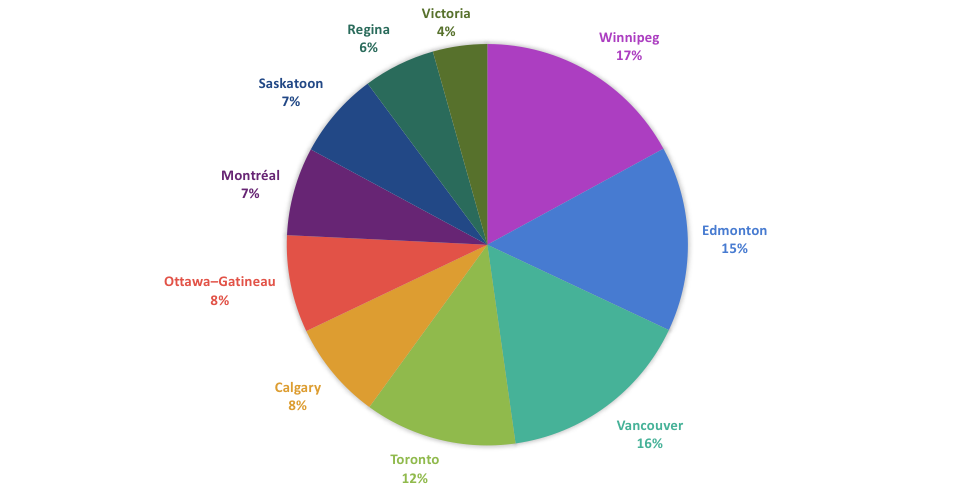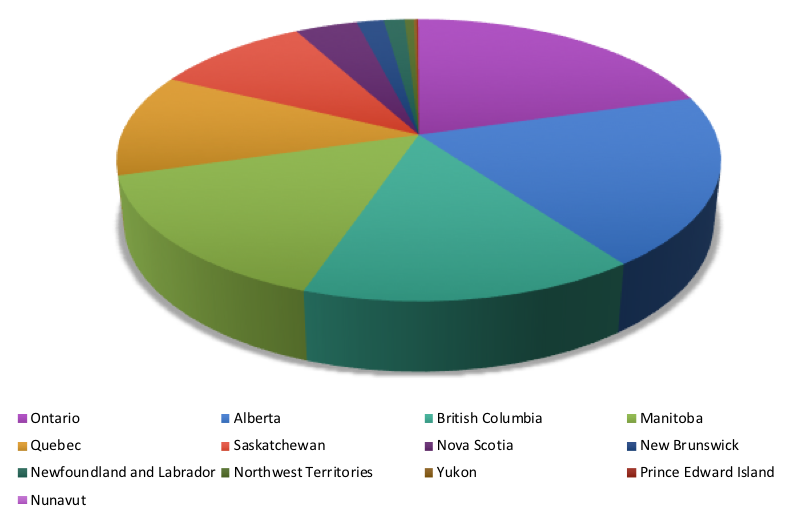25 Demographic Profiles of Indigenous Peoples
Introduction
Statistics Canada categorizes Indigenous Peoples into three groups: First Nations; Métis; and Inuit. Within these broad categories, Statistics Canada publishes two sets of data based on Indigenous identification. First, it collects data on individuals with Indigenous ancestry (under the classification: Aboriginal Ancestry) and second, it collects data on people who self-identify as Indigenous (under the classification: Aboriginal Identity). According to the 2016 population census, 2,130,520 people in Canada reported being of Indigenous ancestry. Of these, 1,525,570 were First Nations; 79,130 were Inuit; and 59,995 were Métis. Most people of Indigenous ancestry lived off-reserve (1,792,035 compared to 380,360 who lived on reserve). In 2016, 1,673,785 people self-identified as Indigenous, representing 4.9 percent of the total Canadian population. Of these, 977,235 (58.4 percent) identified as First Nations, 587,545 (35.1 percent) as Métis, and 65,025 (3.9 percent) as Inuit (Statistics Canada, 2016). Statistics Canada uses data on Indigenous identity to analyze socio-economic trends and population growth.
Indigenous Peoples represent the fastest growing and youngest population in Canada. Between 2006 and 2016, the Indigenous population grew by 42.5 percent, four times the non-Indigenous population growth rate; people under the age of 25 accounted for 44 percent of that growth (Globe and Mail, 2017). This population growth has been attributed to both natural and cultural factors. High fertility rates and long-life expectancies have been two contributing factors. Another has been the fact that more people have become conscious and proud of their Indigenous heritage to the extent that they feel comfortable identifying with it. Population projections indicate that the number of Indigenous Peoples will continue to proliferate, exceeding 2.5 million in the next two decades (INAC, 2012).

First Nations

Indigenous and Northern Affairs Canada (INAC) defines First Nations as both Indigenous Peoples who are identified by the Indian Act as having Indian status (registered and treaty status) and Indigenous Peoples who do not have Indian status under the Indian Act (non-registered). There are more than 630 First Nations communities in Canada; as of 2018, INAC recognizes 618 of them. The 630 communities are made up of approximately 50 broader Nations spread across the entirety of Canada and speaking about 50 unique languages (INAC, 2008). While Ontario has the largest First Nations population (24.2 percent of the total First Nations population), most First Nations live in the western provinces: British Columbia (17.7 percent), Alberta (14.0 percent), Manitoba (13.4 percent), and Saskatchewan (11.7 percent). On a national level, First Nations account for 2.8 percent of the total population of Canada. However, they represent about 10 percent of the population in Manitoba and Saskatchewan, and about 33 percent of the population in the Northwest Territories (NWT).
First Nations account for the most significant proportion of Indigenous Peoples, numbering 977,235 people (58.4 percent of the total). Of this population, 744,855 (approximately 76.2 percent) had Indian status (registered and treaty status) in 2016, an increase of 30.8 percent from 2006 to 2016, and 232,375 (23.8 percent) did not have registered or treaty Indian status, an increase of 75.1 percent between 2006 and 2016.
Of the total First Nations population, 336,055 (44.2 percent) live on reserves or Crown land, which suggests that most First Nations persons live off-reserve and in urban areas. From 2006 to 2016 First Nations contributed 39 percent to the overall Indigenous Peoples population growth. First Nations population growth occurred both on-reserve (12.8 percent) and off-reserve (49.1 percent) (Statistics Canada, 2016, 2017a).
Métis
The Métis belong to a distinct Nation with its own culture, language (Michif), political organizations, and economic practices (Métis National Council, 2018). While Métis identity tends to be defined racially, as “mixedness,” by government bodies such as Statistics Canada, Andersen (2008) argues that this threatens to misrepresent who the Métis are and erase the history and existence of the Métis Nation, a political entity with a homeland that includes Manitoba, Saskatchewan, Alberta, parts of Ontario, British Columbia, the Northwest Territories, and the northern United States (Métis National Council, 2018). With this caveat in mind, the following statistics have been provided from the 2016 census.
In 2016, Statistics Canada reported that the Métis population was 587,545, amounting to approximately 1.7 percent of the national population, a 30-percent increase from 2011. Most Métis live in urban centres (62 percent); however, about 40 percent of these people live in smaller urban centres (Statistics Canada, 2016; Métis National Council, 2018). Provincially, Ontario with a Métis population of 120,585, is home to a majority of Métis; however, the Northwest Territories (at 8.2 percent of total population) and Manitoba (at 7.2 percent of total population) have proportionally larger Métis communities (Statistics Canada, 2016). Some rural areas, specifically in northwestern Ontario and north-central prairie communities like Île-à-la-Crosse, Buffalo Narrows, and the eight Métis settlements in northern Alberta, have communities where Métis are in the majority (Métis National Council, 2018).

Inuit
INAC defines Inuit as the Indigenous Peoples of the Arctic. However, Inuit live in a large area that encompasses a significant 35 percent of Canada’s land mass and about 50 percent of its coastline. Inuit means “the people” in the Inuit language of Inuktitut. Inuit live in more than 53 communities across the northern region that they call Inuit Nunangat (“The place where the people live”) (Inuit Tapiriit Kanatami, n.d.). Nunangat comprises Inuvialuit (NWT and Yukon), Nunavik (northern Quebec), Nunatsiavut (Labrador), and Nunavut. In 2016 the Inuit population was 65,125 and accounted for 3.9 percent of the total Indigenous population. About 30,140 (approximately 64 percent) lived in Nunangat, and approximately 25 percent lived in Nunavik. Most Inuit outside of Inuit Nunangat live in urban areas, with the most significant percentage in Ottawa, Edmonton, and Montreal. Between 2006 and 2016, the Inuit population increased by 29.1 percent, a smaller increase than that experienced by the Métis and First Nations, but still significantly more than the non-Indigenous Canadian population. About 1,335 Inuit live on reserve lands, compared to 63,790 who live off-reserve (Statistics Canada, 2016, 2017a).
References
Andersen, C. (2016). The colonialism of Canada’s Métis health population dynamics: Caught between bad data and no data at all. Journal of Population Research, 33(1), 67. 10.1007/s12546-016-9161-4
Cooke, M., & O’Sullivan, E. (2015). The impact of migration on the First Nations community well-being index. Social Indicators Research, 122(2), 371-389. 10.1007/s11205-014-0697-4
Delic, S. (2009). Statistical information pertaining to socio-economic conditions of northern Aboriginal people in Canada: Sources and limitations. Northern Review, (30), 119.
Globe and Mail. (2017). Census 2016: Canada getting more diverse as immigration, Indigenous population increase. Retrieved from https://www.theglobeandmail.com/news/national/census-2016-highlights-diversity-housing-indigenous/article36711216/
Indigenous and Northern Affairs Canada (INAC). (2012, May 3). Registered Indian population, household, and family projections, 2009-2034 [Statistics]. Retrieved from https://www.aadnc-aandc.gc.ca/eng/1336067778419/1336067821902
Indigenous and Northern Affairs Canada (INAC). (2008, November 3). Welcome to First Nations profiles. Retrieved from http://fnp-ppn.aandc-aadnc.gc.ca/fnp/Main/Index.aspx?lang=eng
Inuit Tapiriit Kanatami. (n.d.). About Canadian Inuit. Retrieved from https://itk.ca/about-canadian-inuit/
Statistics Canada. (2010, June 23). Study: The health of First Nations living off-reserve, Inuit and Métis adults. Retrieved from http://www.statcan.gc.ca/daily-quotidien/100623/dq100623c-eng.htm
Statistics Canada. (2013a, May 8). Aboriginal Peoples Reference Guide, 2011 National Household Survey. Retrieved from http://www12.statcan.gc.ca/nhs-enm/2011/ref/guides/99-011-x/99-011-x2011006-eng.cfm
Statistics Canada. (2013b, November 13). 2011 National Household Survey Aboriginal population profile – province/Territory. Retrieved from http://www12.statcan.gc.ca/nhs-enm/2011/dp-
Statistics Canada. (2015a, November 9). Aboriginal Statistics at a glance: 2nd Edition. Retrieved from http://www.statcan.gc.ca/pub/89-645-x/89-645-x2015001-eng.htm
Statistics Canada. (2015b, November 30). Population growth: Growth rate of population is much higher for Aboriginal peoples. Retrieved from https://www.statcan.gc.ca/pub/89-645-x/2010001/growth-pop-croissance-eng.htm
Statistics Canada. (2017a). Aboriginal peoples in Canada: Key results from the 2016 Census. Retrieved from http://www.statcan.gc.ca/daily-quotidien/171025/dq171025a-eng.pdf
Statistics Canada. (2017b, October 25). Aboriginal Peoples Reference Guide, Census of Population, 2016. Retrieved from http://www12.statcan.gc.ca/census-recensement/2016/ref/guides/009/98-500-x2016009-eng.cfm
Taylor, A. (2011). Current evidence of ‘female flight’ from remote northern territory Aboriginal communities – demographic and policy implications. Migration Letters, 8(2), 77.
The Métis Nation. (n.d.). Who are the Métis? Retrieved from http://www.metisnation.ca/index.php/who-are-the-metis
The First Nations Statistics Institute. (n.d.). Retrieved from http://www.firststats.ca/home.asp

